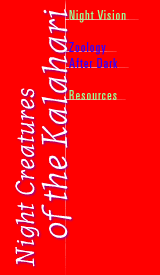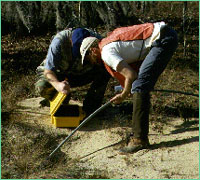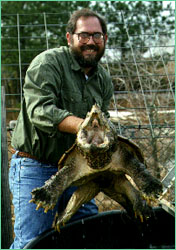 |
Gopher Tortoise—David RostalThe aptly named Gopher tortoise is a master of the underworld, creating and inhabiting elaborate burrows—some up to 30 feet in length. The herbivorous tortoise, which is found in the American south-east, has fascinated David Rostal of Georgia Southern University for 10 years.
DR: Finding them above ground. They probably spend 60-70% of their time underground. You can trap them at the mouth of the burrow, because they do come out to eat every couple of days, but it's extremely time consuming. Getting any real population data on them was tough. NOVA: Tell me about the technology you now use to study Gopher Tortoises in the field. DR: Well, we call it a "Burrow Cam." The unit that we have is made by a gentleman named Ed Wester. It's basically an infrared video camera system mounted on the end of a telescoping tube that we can run down inside the burrow. Around the lens is a series of infrared lights and we have a video monitor that stays above ground. Our particular system cost about $1000. The telescoping tube has to make a lot twists and turns in order to reach the back of the burrow, where hopefully we find a tortoise. NOVA: Can the tortoises see the infrared light?  DR: Yeah, they can to a degree. They will notice it and respond to it.
DR: Yeah, they can to a degree. They will notice it and respond to it.NOVA: Do they ever snap at it? DR: No, no. These are extremely gentle animals. NOVA: What has the "Burrow Cam" enabled you to discover about the Gopher Tortoise that you otherwise would have missed? DR: Our primary use of the "Burrow Cam" has been to evaluate tortoise population numbers and to identify symbiotic relationships with other animals. We're pretty sure we've had about an 80% decline in the tortoise population over the last 100 years due to habitat loss. Georgia is probably the last stronghold for them in the world. And there's literature, mostly from Florida, showing that about 80 vertebrate species and over 200 invertebrate species depend on these burrow systems for shelter. In Georgia, we're particularly interested in the indigo snake, which utilizes these burrows during the winter months. The "Burrow Cam" has allowed us to learn in a day what used to take a month or more. (back) Photos: (1) Doug Jones; (2) David Rostal. Night Vision | Zoology After Dark Resources | Guide | Transcript | Night Creatures Home Editor's Picks | Previous Sites | Join Us/E-mail | TV/Web Schedule About NOVA | Teachers | Site Map | Shop | Jobs | Search | To print PBS Online | NOVA Online | WGBH © | Updated November 2000 |
